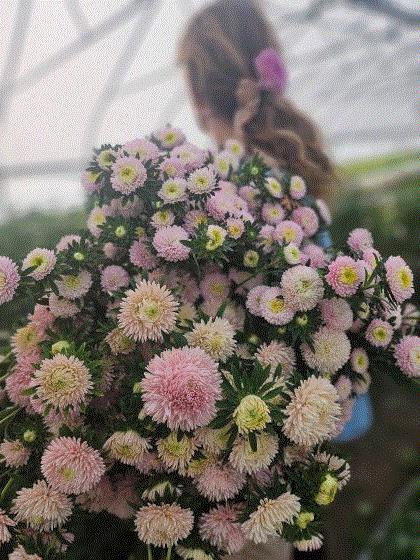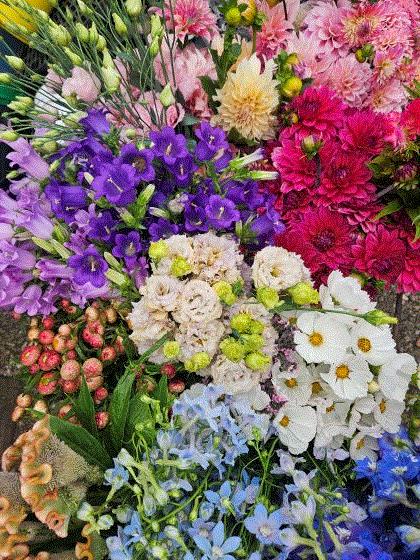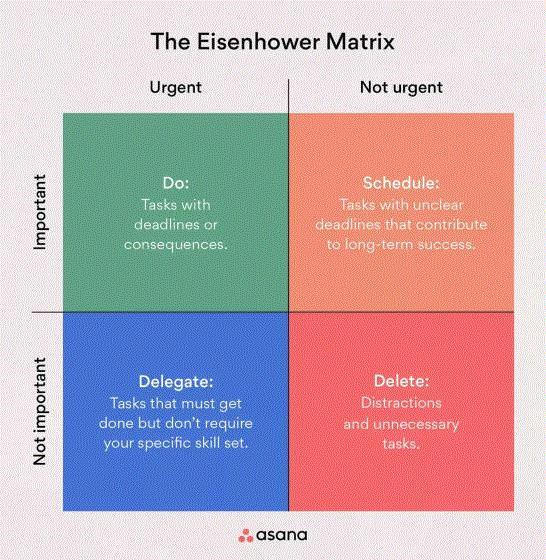Succession-Planting Asters

Bonita Shell Pink and Tower Chamois asters from last season
Some flowers, like asters, can be a little tricky to succession plant. Last season, I had two successions of asters, planted one month apart, and yet for some reason they all flowered at the same time. Our florists loved them, but they were a one-hit wonder last season. Tater and I would like to have them more often this season.
So I reached out to Bob Croft, Product Technical Manager at aster breeder Sakata, to learn the in’s outs of aster production. Come to find out, you can have asters year round—IF you manipulate the photoperiod. Here are some key points to keep in mind:
- Aster calistephus has a built-in vegetative stage and becomes receptive to flower bud initiation at the 5th true leaf stage. The key is to transplant at the 3rd true leaf stage, and then the plants will have two weeks to establish in the final planting bed. Do not allow plugs to get rootbound.
- Once the crop is established in the final planting bed, it’s best to using lighting to apply long days. Remember, the number of leaves dictates when plants become receptive to flower bud initiation. Maintain night interruption lighting until the crop is two-thirds the desired height.
- Late successions of fall and holiday flowering asters may need to be lit longer to achieve the height requirements and to combat short days.
- Asters are best finished under short days (less than 12 hours) for the fastest finishing time. Plants will finish under long days but it takes an additional week or two to finish.
- Azumi XL and Bonita asters can be disbudded to make a focal flower.
Tater and I are excited to try this! It pays to understand the nuances of the crops you are growing. The current plan is to sow them once per month in hopes to have asters from July to Christmas. And we look forward to trying the
Azumi XL and
Bonita series throughout the season. Azumi XL Red looks promising for holiday sales. We’ll let you know how it goes.
Are there any asters you are excited to grow this season? Tater and I would love to hear from you. Drop us a line at
ldaschner@ballpublishing.com.

Succession Planting Simplified

The key to abundance all season long is succession planting! It takes discipline, but it's worth it.
Dave Dowling and the cut flower gurus at Ball Seed made this easy
GUIDE for succession planting. If you are late to the planning game, this may be your get-out-of-jail-free card. Check out Dave’s notes below:
Cut Flowers to Succession Plant:
Sunflowers – every week until August 15
Crested Celosia/Coxcomb – every three weeks until August 1
Wheat Celosia – every three weeks until August 1
Plume Celosia – every four weeks until August 1
Zinnias – every three weeks until August 1
Ageratum – Start a second planting in mid-July by rooting cuttings from the first planting
Gomphrena – Every three weeks until mid-July
China Asters – Sow seeds March 15 and April 15. Asters started after May 1 need night interruption lighting from the seedling stage until they are almost the desired height.
Strawflower – Every three weeks until mid-July
Amaranthus – Second planting in early July
Cosmos – Every three weeks until mid-July
Gladiolus – Every three weeks until mid-July
Marigold – Every three weeks until Mid-July
Snapdragon – Every three weeks until mid-July. Plant Group 4 in March to June, Groups 3 or 4 in July.
Lily – Plant every two or three weeks starting three weeks before last spring frost date until 14 weeks before first fall frost.
Calla – Plant every four weeks from just after last spring frost through late July.
For further reading, here is Dave’s Hardy and Annuals and Cool Flowers
Guide and Summer and Fall Planted Plug
Guide. Remember, your time is valuable, these cheat sheets will save you a lot of guess work later. Be sure to bookmark them!

Enterprise Budgets: a Coping Skill for Tariffs?
I think enterprise budgets are going to be a must for all farms this season. Shooting from the hip only works for so long, and if you aren’t certain that your farm will profit from a certain crop, it probably doesn’t make sense to grow it!
In the looming era of tariffs, its hard telling what our plants, utilities and hardgoods costs will be at certain points in the season. The best way to combat fear and uncertainty is with information! That is where an enterprise budget come in.
What is an enterprise budget? According to Google's AI overview, an enterprise budget is “a detailed financial plan for a specific business unit or product, outlining its projected income and expenses for a defined period, such as a year or a production cycle. It helps businesses estimate profitability and make informed decisions about investments and production.”
What they do is take the guesswork out of pricing while allowing you to factor in a profit. They will help you understand your costs and profitability. You can model different scenarios and decide what will be best for your farm and financial goals. An enterprise budget can serve as a financial compass, giving you a framework for making decisions and increasing profitability.
If you are new to this, do not worry! You can make your enterprise budget as simple or complex as you want. But don’t make it so hard on yourself that you won't use this tool. If you don’t have the exact numbers for certain line items, you are better off with a educated/calculated estimate rather than leaving it blank. Just be sure to make yourself a note if you are making any assumptions for your calculations.
I suggest you start with your three most expensive crops to produce (in our case, it's dahlias, winter-grown anemone and ranunculus). As time goes on, you can pick sample crops that can serve as a model for similar crops. For instance, dara (wild carrot) and ammi (false Queen Anne's lace) behave similarly in the field, so there is a good chance that the enterprise budget for one will work for the other. Don’t make things complicated, make this a tool that is user-friendly for you.
Tater and I are already thinking about trying this on our anemone and ranunculus order that is slated to come in August. It’s tough, because we need these plants for our winter 2026 production, but we placed the order without knowing the plant costs.
I encourage you to take action! Put pen to paper and start modeling different scenarios. That’s our plan, and it sure helps ease the worry in uncertain times.
Thank you for listening to my soapbox speech! We’ll ride these waves together and get through. Remember how challenging Covid was? If we can get through that, we can get through anything. Just remember, knowledge and numbers are power.

Webinar Alert! Postharvest Recommendations

Our friends at
American Floral Endowment (AFE) have a curated series of webinars each month for their Grow Pro Webinar series, and this month’s webinar is all about postharvest! It’s going to be a real treat, since Dr. John Dole, one of the industry's postharvest expert, will be leading the charge.
Dr. Dole is a Professor in the Horticulture department at NC State University. He has conducted extensive research on postharvest handling and his team of graduate students have tested hundreds of cut flower species and cultivars in his postharvest lab. Trust me, you’ll want to tune in for this talk!
Date: April 22, 2025
Time: 1 p.m. EDT
In this talk, Dr. Dole will cover how to handle the most important cut flowers, showcase the latest research-based recommendations to optimize postharvest handling, and help you get a better grip on how to handle challenging species of cut flowers postharvest.
Thank you, American Floral Endowment, for this timely and relevant content!

How to Maximize Productivity

We are all trying to squeeze 26 hours' worth of tasks into a 24-hour day, which we all know is impossible. There are only two other options: drive yourself crazy trying to complete your never-ending to-do list, or make better use of your time and delegate tasks.
This season, my goal is to master option 2. It sounds really simple in theory, but it’s easier said than done. I stumbled upon an interesting blog on
Enableag.com on this very subject, with these tips:
Assess your time. How do you spend your time each week? What tasks are things that only you can do? Take a honest look at your workflow. Are there things that your employees can help you with?
Prioritizing tasks. Outline your tasks for the week based on importance and urgency. I am eager to try the
Eisenhower Matrix. Complete high value and high priority tasks first.
Delegation and outsourcing. Are there any tasks you can outsource? What things can your team take off your plate? Delegation is an art form (more on this in another edition), but it’s important to start thinking about training your team to handle new tasks before you get into peak season. What software can you use to help automate and complete certain tasks?
Time blocking and boundaries. Schedule your personal time and work hours. Remember, you don’t have to schedule every hour of your day, but work-life balance takes practice. Only you can protect your personal time. Just because someone wants to pick up flowers on a Sunday afternoon doesn’t mean you should be willing to forgo your personal time. Boundaries are important, and your emotional wellbeing will thank you. The dynamic duo at the
Dirt on Flowers recorded an entire podcast on boundaries. It’s worth the listen.

Happy Birthday, Tater!

Happy Birthday, Tater! Nine looks good on you.
Fellow editor Bill Calkins posted in the Greenhouse Tech Team Facebook group about greenhouse dogs. (If you aren’t a member of this group, you should be!). If you need a smile today join the group and check out the comments. Greenhouse growers from all over the country posted photos of their beloved farm pups with their flowers.
Sweet Tater turned nine at the end of March. She’s my best friend and she’s my sanity during peak season. I would be lost without her. Tater and I are building Forget Me Not together—she’s been with me since the beginning.
During the hustle and bustle of planting season and Mother’s Day, I try to remember to take stock in the little things. There are a million challenges when you are farming and self-employed. But bringing my best friend to work tips the scale the other way. Happy birthday, Tater! Here’s to another year of chasing rabbits and slinging Michigan’s best flowers!
Until next time,
Lindsay Daschner (and Tater)
Editor-at-Large—Bloom Beat
Owner—Forget-Me-Not Farms
This email was received by 6,269 of your fellow fresh-cut flower growers!
If you're interested in advertising in Bloom Beat, contact Kim Brown and she will hook you up!